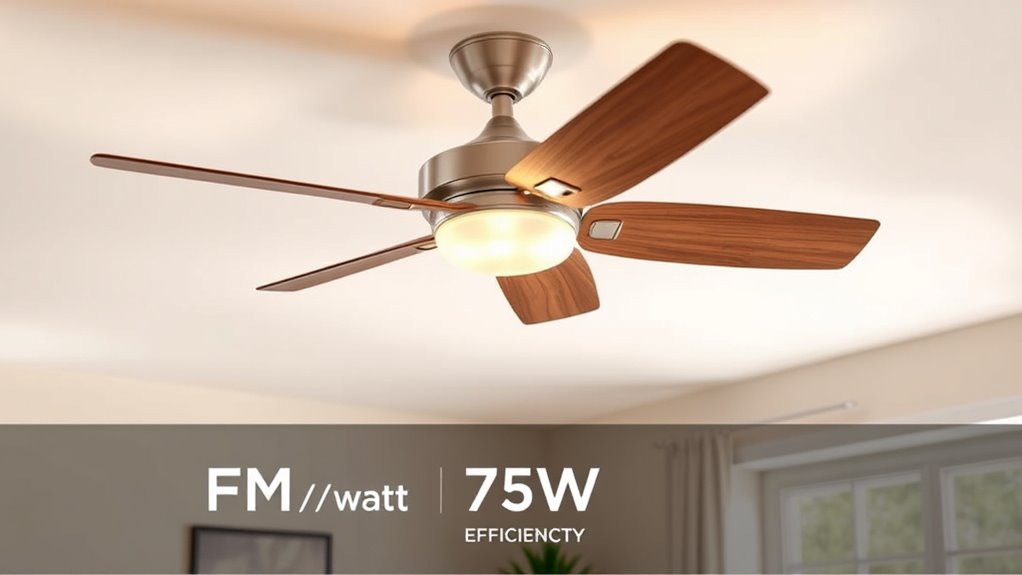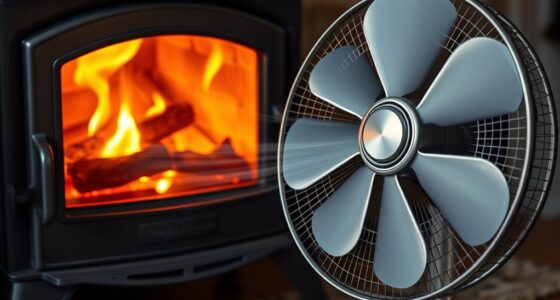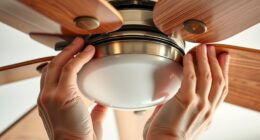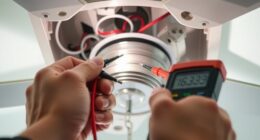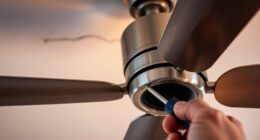Understanding ceiling fan efficiency isn’t just about CFM or wattage alone—it’s about CFM per watt. This ratio shows how well a fan moves air for the energy it consumes. High CFM per watt means better airflow with less power, saving you energy and reducing bills. But many overlook blade design and speed settings that impact this ratio. To learn how to find the most efficient fans for your space, explore the full guide.
Key Takeaways
- Higher CFM per watt indicates more efficient airflow with less energy consumption, crucial for selecting energy-saving ceiling fans.
- Blade design, shape, and pitch significantly impact both airflow and energy efficiency, influencing CFM per watt.
- Increasing fan speed boosts airflow but often decreases CFM per watt, reducing overall efficiency.
- Proper installation and high-quality components optimize fan performance and maximize CFM per watt.
- Comparing fans using CFM per watt helps identify models that balance strong ventilation with lower energy costs.
Understanding the Basics: What Is CFM and Wattage?

To understand ceiling fan efficiency, it’s important to know what CFM and wattage mean. CFM, or cubic feet per minute, measures how much air the fan moves, directly affecting airflow patterns in your space. Wattage indicates how much power the fan consumes, which impacts energy use. A fan with well-designed blades enhances airflow by creating efficient airflow patterns, often influenced by the fan blade design. The shape, pitch, and number of blades determine how effectively the fan circulates air. Higher CFM means better airflow, but it also depends on the wattage required to achieve that airflow. Additionally, blade design plays a crucial role in optimizing both airflow and energy efficiency, ensuring you get the most effective ventilation with less power consumption. By understanding these basics, you can better evaluate how a fan’s blade design and power consumption work together to provide efficient ventilation and comfort.
The Significance of CFM per Watt in Energy Efficiency

Understanding CFM per watt helps you see how efficiently your ceiling fan uses energy to move air. By analyzing power consumption, you can identify models that provide better airflow for less energy. This knowledge allows you to optimize airflow while saving on energy costs.
Power Consumption Analysis
Since higher CFM per watt indicates more efficient airflow, evaluating this ratio is essential for energy-conscious consumers. A ceiling fan with a good CFM per watt ratio consumes less power while delivering adequate airflow, reducing energy bills. Pay attention to noise levels, as inefficient fans with lower ratios often generate more noise due to strain on motor components. Proper installation techniques also play a role; secure, well-aligned mounting can optimize power use and minimize unnecessary energy waste. By analyzing power consumption alongside CFM per watt, you can identify models that balance airflow and efficiency. Additionally, understanding Mazda Tuning principles can inspire innovative ways to improve your home’s ventilation system for better performance and energy savings. This helps you choose fans that not only save energy but also operate quietly, enhancing comfort without increasing your electricity costs.
Optimizing Airflow Efficiency
Optimizing airflow efficiency hinges on selecting ceiling fans that deliver high CFM per watt ratings. To do this, focus on airflow dynamics, which determine how effectively air circulates. A well-designed fan promotes better airflow with less energy. Fan blade design plays a vital role; aerodynamically optimized blades reduce drag and improve airflow per watt, making your fan more efficient. Look for fans with blades shaped to maximize air movement while minimizing power use. Properly balancing fan speed and blade pitch can also enhance airflow dynamics. By choosing fans with superior CFM per watt ratings and thoughtful blade design, you guarantee maximum ventilation with minimal energy consumption. This approach helps you achieve better air circulation while keeping your energy bills in check. Additionally, understanding bedroom design elements can contribute to creating a comfortable and efficient living space that complements your ventilation needs.
How to Calculate CFM per Watt for Your Ceiling Fan

To accurately determine your ceiling fan’s efficiency, you need to calculate its CFM per watt. First, find the fan’s airflow, measured in cubic feet per minute (CFM), which depends on blade design—more aerodynamically optimized blades move more air with less effort. Next, note the fan’s power consumption in watts, usually listed on the label or in the manual. Divide the airflow (CFM) by the wattage to get your CFM per watt. Keep in mind, blade design influences noise levels; fans with well-designed blades tend to operate more quietly while maintaining high airflow. Additionally, understanding credit card terms can be helpful if you’re financing your ventilation upgrades or purchasing new fans. This calculation helps you understand how effectively your fan converts energy into airflow, setting the stage for selecting models that balance efficiency and comfort.
Why Higher CFM per Watt Matters for Your Comfort
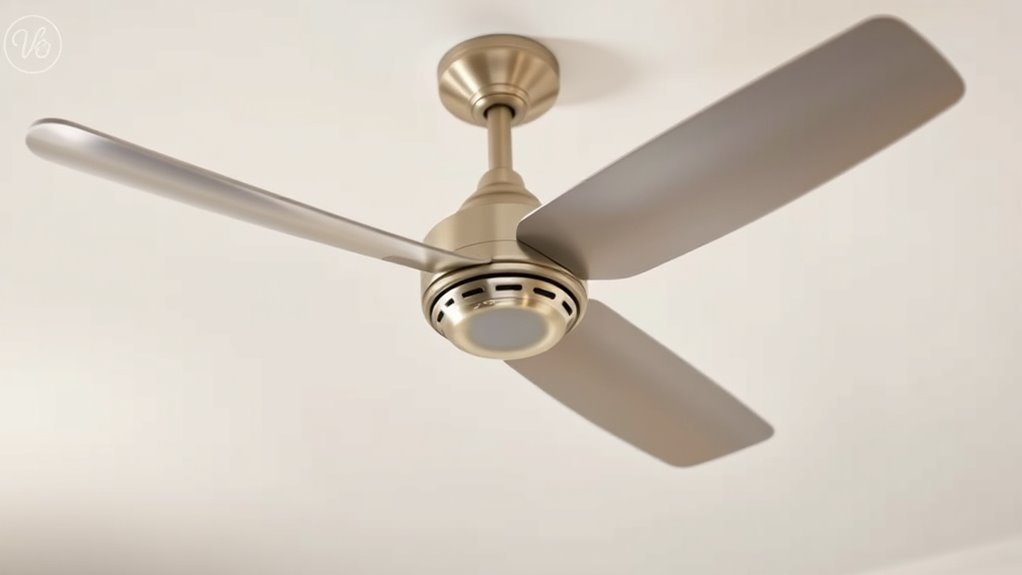
A higher CFM per watt means your ceiling fan moves more air for less energy, directly impacting your comfort. When airflow distribution is efficient, cool air spreads evenly across the room, preventing hot spots and improving overall climate control. Fan blade design plays a vital role here; well-designed blades maximize airflow while minimizing energy use. This means you get better airflow without increasing power consumption, making your fan more effective and economical. When your fan delivers higher CFM per watt, it can circulate air more efficiently, enhancing comfort during warmer months or even assisting in ventilation. Proper fan tuning can further optimize performance and energy savings. Ultimately, choosing a fan with a higher CFM per watt ensures you stay comfortable while saving energy and reducing your electricity bills.
Common Misconceptions About Fan Power and Airflow
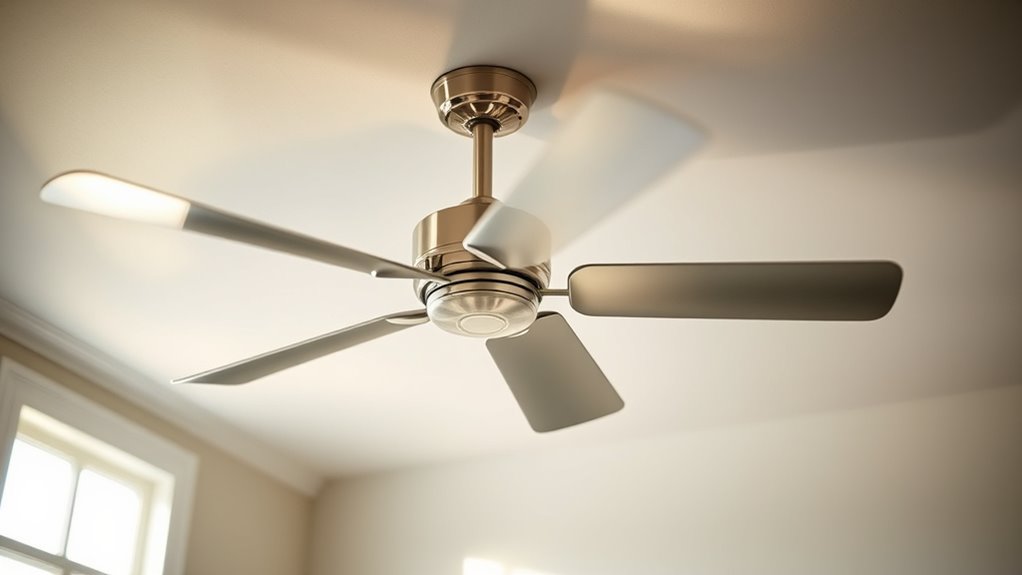
Many people assume that higher power means more airflow, but that’s not always true. You might think a wattage increase improves performance, yet it often doesn’t. It’s important to understand how CFM ratings can be misunderstood and don’t directly correlate with wattage. For example, in remote hackathons, teams often innovate around optimizing efficiency rather than simply increasing power usage.
Power Doesn’t Equal Airflow
Just because a ceiling fan consumes more power doesn’t mean it will move more air. Airflow depends more on blade design and motor efficiency than wattage. A high-wattage fan with poor blade aerodynamics won’t produce better airflow than a lower-wattage model with optimized blades. To understand this better, consider the table below:
| Fan Model | Power Consumption | Airflow (CFM) | Blade Design | Motor Efficiency |
|---|---|---|---|---|
| Model A | 75W | 4,000 CFM | Curved blades | High |
| Model B | 75W | 3,500 CFM | Flat blades | Moderate |
| Model C | 50W | 3,800 CFM | Aerodynamic blades | High |
| Model D | 50W | 3,200 CFM | Basic blades | Moderate |
| Model E | 100W | 4,200 CFM | Optimized blades | Very high |
This shows that efficiency and design matter more than wattage alone. Additionally, understanding cybersecurity vulnerabilities in electronic components can help prevent potential system failures.
Higher Wattage Doesn’t Mean Better
Believing that higher wattage automatically means better airflow is a common misconception. More wattage doesn’t necessarily translate to more efficient or eco-friendly design. In fact, a fan with lower wattage can deliver excellent airflow while reducing noise and energy consumption. Imagine:
- A sleek fan quietly circulating air without buzzing or rattling.
- An eco-friendly design that maximizes airflow per watt, saving energy.
- A modern fan that uses less power but moves air efficiently across the room.
- Quiet operation that minimizes noise while maintaining ideal ventilation.
Misreading CFM Ratings
While a high CFM rating might suggest powerful airflow, it doesn’t always mean the fan is more effective or efficient. Many assume that a higher CFM guarantees better performance, but factors like fan blade design and noise levels matter. For example, a fan with a high CFM but poor blade design may produce more noise and less airflow efficiency. Here’s a quick comparison:
| Fan Model | CFM Rating | Noise Levels (dB) |
|---|---|---|
| Model A | 6000 | 55 |
| Model B | 5000 | 40 |
| Model C | 7000 | 65 |
| Model D | 5500 | 35 |
Look beyond the CFM and consider blade design and noise levels for a truly effective fan. Additionally, understanding how fan power and airflow relate can help you select a more energy-efficient model.
Comparing Ceiling Fans: Finding the Most Efficient Options
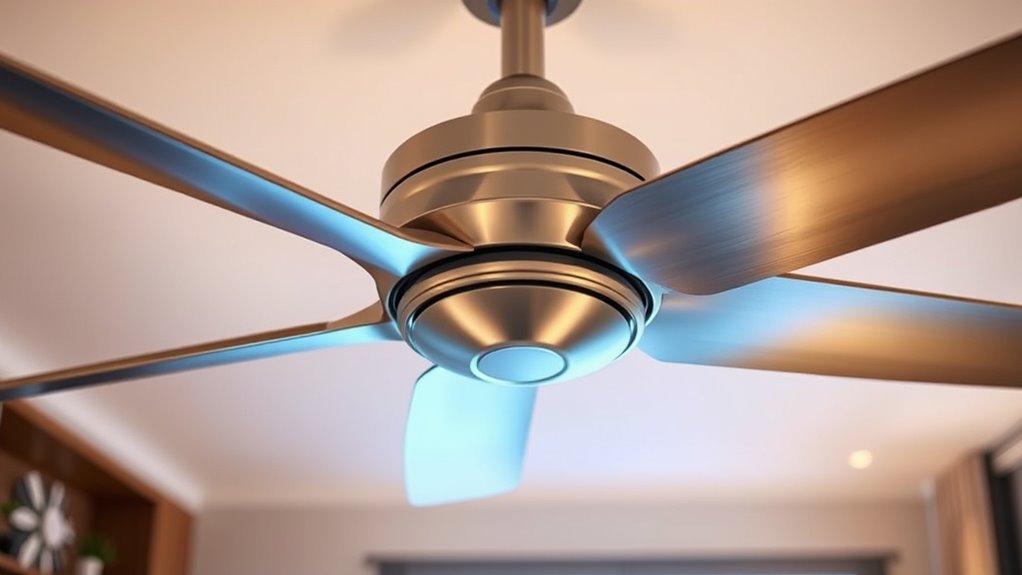
To find the most effective ceiling fan, you should compare models based on their airflow per watt (CFM/W). Look for fans with ideal blade design, which maximizes airflow while minimizing energy use. Focus on motor efficiency, as a high-quality motor converts electricity into airflow more effectively. Visualize these factors with:
Choose ceiling fans with high CFM/W for efficient airflow and energy savings.
- Sleek blades that cut through air smoothly, reducing drag.
- Aerodynamic blade shapes that boost airflow without extra power.
- Motors with advanced technology that deliver higher CFM/W ratios.
- Compact, efficient designs that combine form and function seamlessly.
- Additionally, selecting fans with energy-efficient components can further enhance performance and reduce electricity consumption.
The Impact of Fan Speed Settings on CFM per Watt

Adjusting your ceiling fan’s speed settings directly influences its airflow efficiency, measured in CFM per watt. Running the fan at higher speeds increases airflow but often decreases efficiency, as more power is used for marginal gains in airflow. Conversely, lower settings can improve CFM per watt, making the fan more energy-efficient. Keep in mind, higher speeds tend to generate more motor noise, which can be distracting. If your fan has a remote control, you can easily switch between speeds to find the most suitable balance between airflow and efficiency. Using the remote allows quick adjustments without disturbing your comfort. Ultimately, selecting the right speed setting helps maximize CFM per watt while keeping motor noise manageable, ensuring your fan performs efficiently without unnecessary energy use. Additionally, understanding the impact of fan speed settings on CFM per watt can help you optimize your ventilation system for both comfort and energy savings.
Tips for Choosing a Ceiling Fan With Optimal CFM per Watt

Choosing a ceiling fan with ideal CFM per watt starts with understanding your room size and airflow needs. Focus on blade design, as larger or aerodynamically shaped blades move more air efficiently, improving CFM per watt. Consider noise levels; quieter fans often have optimized blade designs that reduce sound without sacrificing airflow. To select the best fan:
- Visualize a sleek blade design that slices through air smoothly.
- Imagine a fan operating quietly, barely noticeable in your space.
- Think of a model with adjustable blade pitch for tailored airflow.
- Envision a balanced fan with minimal wobble, reducing unnecessary noise.
- Incorporate vertical storage solutions to keep your space organized and free from clutter, ensuring the fan operates without obstructions that could affect airflow.
Prioritize fans that combine smart blade design with low noise levels for maximum efficiency. This ensures you get powerful airflow without wasting energy.
Real-Life Examples of Energy-Saving Ceiling Fans

Many homeowners have found that energy-efficient ceiling fans can substantially cut energy bills while maintaining effective airflow. One real-life example is a family who replaced their old fan with one featuring a sleek, aerodynamically optimized fan blade design. This upgrade improved airflow and reduced wattage consumption, demonstrating a clear energy saving tip. By choosing fans with well-designed blades, they achieved higher CFM per watt, meaning more efficient cooling. Another example involves a small business that installed ceiling fans with high CFM per watt ratings in their workspace. These fans helped lower cooling costs without sacrificing comfort. These real-life cases highlight how paying attention to fan blade design and applying simple energy-saving tips can make a significant difference in your energy bills and comfort. Additionally, understanding the importance of attention in creative practice can help you focus on selecting and maintaining the most efficient cooling solutions for your space.
Frequently Asked Questions
How Does Room Size Affect Ideal CFM per Watt?
Room size directly impacts the ideal CFM per watt for your ceiling fan, as larger rooms require higher airflow to combat ventilation challenges and poor insulation. You need a fan with a higher CFM per watt to circulate air effectively without wasting energy. Smaller rooms, with better insulation, need less airflow, so the CFM per watt can be lower. Adjusting based on room size guarantees maximum comfort and energy efficiency.
Can Ceiling Fan Placement Influence CFM per Watt Efficiency?
You can’t judge a book by its cover, and the same goes for fan placement. Proper placement boosts cfm per watt efficiency by optimizing airflow. Position your fan where it can best utilize blade angles and motor efficiency, like near the center of the room or away from obstructions. When you place it right, you’ll notice better performance and energy savings — it’s all about working smarter, not harder.
Are There Specific Brands Known for High CFM per Watt?
Some brands stand out for high CFM per watt, thanks to strong reputation and top energy ratings. For instance, Hunter and Minka-Aire are known for efficient fans that deliver excellent airflow with lower energy use. You’ll find these brands prioritize motor efficiency and innovative designs, helping you save on electricity bills while keeping your space comfortable. When choosing, check their energy ratings and reviews to guarantee you get the best performance.
How Does Maintenance Impact a Fan’s Energy Efficiency?
Think of your fan as a finely tuned machine; dust accumulation and lack of motor lubrication are like rust, weighing it down. When you clean dust from blades and guarantee proper lubrication, you keep it running smoothly, boosting energy efficiency. Regular maintenance reduces strain on the motor, helping it use less power for the same airflow. So, a well-maintained fan saves energy and cools your space more effectively.
What Role Does Blade Design Play in CFM per Watt?
You’ll find that blade design critically impacts CFM per watt because aerodynamic blade shapes reduce drag and improve airflow, making your fan more efficient. Additionally, fan blade materials influence performance; lightweight materials like plastic or composite allow easier movement, increasing efficiency. Combining sleek blade aerodynamics with ideal materials ensures your ceiling fan moves air effectively without wasting energy, helping you stay cool while saving on electricity.
Conclusion
Now that you know the secrets to smarter airflow, you can select fans that save energy and boost comfort. Focus on finding fans with fantastic CFM per watt to maximize efficiency. Don’t let misconceptions muddle your decision—measure, compare, and choose wisely. With these tips, you’ll turn the mundane task of fan shopping into a mindful, money-saving move. Make your home cooler, cleaner, and more cost-conscious—because smart choices lead to sensational comfort.
